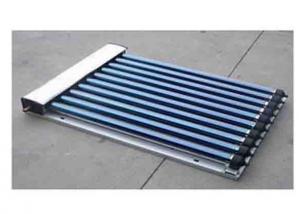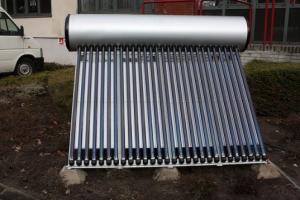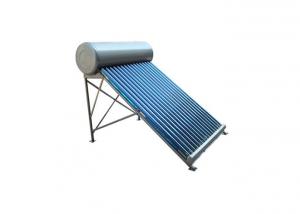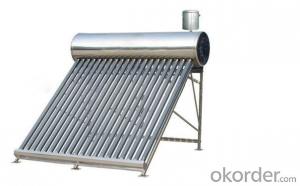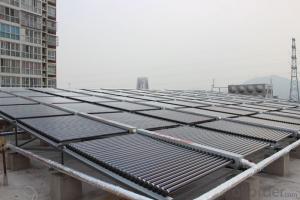Solar Collectors Cyprus Non-Pressurized Solar Water Heater
- Loading Port:
- China Main Port
- Payment Terms:
- TT or LC
- Min Order Qty:
- 1 Set set
- Supply Capability:
- 500000 Sets per Year set/month
OKorder Service Pledge
OKorder Financial Service
You Might Also Like
Solar Water Heater
1.Warm place available
2.the most competive price
3.Beautiful design
4.Best service and high quality
Working principle:
High quality vacuum tubes absorb sunshine and heat cold water in the vacuum tubes. According to the density difference of cold and hot water, when absorbing sunshine, cold water in vacuum tubes turning to hot water rises to tank, meanwhile, cold water in tank sinks to vacuum tubes. That is the circulation in this type of solar water heater. The whole system is always circulating continuously.
Specification:
1. Inner tank:SUS304-2B food grade stainless steel,Thickness:0.4-0.7mm
2. Outer tank material: SUS304-BA stainless steel,0.4-0.5mm
3. Bracket: stainless steel thickness:1.5mm
4. Vacuum tube; 47mm/58mm diameter, 1500mm/1800mm length
5. Insulation layer: 50-55mm polyurethane foam
6. Inner tank dia.:320/360/380mm
7. Obliquity of the bracket: 17/20/22/25/30/38/45 degree
8. Assisstant water tank or digital controller optional.
9. Back-up electric heater potional
10. Heat preservation: 72-80 hours
11. Inlet ,outlet are welded
12. Capacity:90-400L
13. Quality guarantee:6 years
Model list:
Model |
Vacuum tube |
Outer tank Dia |
Water Capacity |
Absorbe area
sq.m. |
Person | ||
Tank |
Vacuum tube |
Total | |||||
JW47-15 |
Φ47mm*1500mm*15 |
420mm |
90L |
19L |
109L |
0.83 |
1--2 |
JW47-16 |
Φ47mm*1500mm*16 |
420mm |
95L |
21L |
116L |
0.88 |
1--2 |
JW47-18 |
Φ47mm*1500mm*18 |
420mm |
106L |
23L |
129L |
0.99 |
1--3 |
JW47-20 |
Φ47mm*1500mm*20 |
420mm |
120L |
------ |
--- |
1.05 |
2--3 |
JW47-24 |
Φ47mm*1500mm*24 |
420mm |
140L |
------ |
---- |
1.26 |
2--3 |
JW47-26 |
Φ47mm*1500mm*26 |
420mm |
151L |
------ |
---- |
1.365 |
2--3 |
JW47-30 |
Φ47mm*1500mm*30 |
420mm |
174L |
------- |
----- |
1.575 |
2--4 |
JW47-36 |
Φ47mm*1500mm*36 |
420mm |
210L |
------- |
---- |
1.89 |
2--3 |
| |||||||
JW58-12 |
Φ58mm*1800mm*12 |
470mm |
103L |
32L |
135L |
1.0 |
2--3 |
JW58-16 |
Φ58mm*1800mm*16 |
470mm |
136L |
43L |
179L |
1.28 |
2--3 |
JW58-18 |
Φ58mm*1800mm*18 |
470mm |
152L |
48L |
200L |
1.44 |
2--3 |
JW58-20 |
Φ58mm*1800mm*20 |
470mm |
168L |
54L |
222L |
1.6 |
2--3 |
JW58-24 |
Φ58mm*1800mm*24 |
470mm |
200L |
64L |
264L |
1.92 |
2--4 |
JW58-30 |
Φ58mm*1800mm*30 |
470mm |
250L |
80L |
330L |
2.4 |
2--5 |
JW58-36 |
Φ58mm*1800mm*36 |
470mm |
300L |
95L |
395L |
2.88 |
4--7 |
- Q: Can solar collectors be used for generating electricity on smartwatches?
- Solar collectors can potentially be used for generating electricity on smartwatches, although there are certain limitations and challenges to consider. The small size of smartwatches poses a challenge in terms of the amount of solar energy that can be harnessed. The limited surface area available for solar collectors makes it difficult to generate a significant amount of electricity to power the device. Additionally, smartwatches are often worn on the wrist, which may not always be exposed to direct sunlight. This further limits the effectiveness of solar collectors in generating electricity consistently. However, there have been advancements in solar cell technology that are specifically designed for small, portable devices like smartwatches. These solar cells are more efficient in capturing sunlight even in low light conditions and can be integrated into the display or strap of the watch. Some smartwatches already incorporate small solar panels to supplement battery life, although the primary source of power is still typically derived from traditional charging methods. While solar collectors on smartwatches may not be the sole source of power, they can certainly help in extending battery life and reducing reliance on external charging. This can be particularly useful in situations where access to charging outlets is limited, such as during outdoor activities or travel. In conclusion, while solar collectors can be used for generating electricity on smartwatches, their effectiveness is currently limited by the small size and limited exposure to sunlight. However, advancements in solar cell technology may lead to more efficient and practical solutions in the future.
- Q: Can solar collectors be used for generating electricity on boats?
- Yes, solar collectors can be used for generating electricity on boats. Solar panels can be installed on the boat's roof or any other suitable surface to capture sunlight and convert it into electrical energy. This can provide a sustainable and renewable source of power for various onboard systems and appliances, reducing the reliance on fossil fuels and enhancing the boat's energy efficiency.
- Q: Can solar collectors be used for heating assisted living facilities?
- Yes, solar collectors can definitely be used for heating assisted living facilities. Solar thermal systems can effectively capture solar energy to provide hot water and space heating for buildings. This renewable energy source can significantly reduce heating costs and carbon emissions, making it a sustainable and efficient option for assisted living facilities.
- Q: Can solar collectors be used for heating playgrounds?
- No, solar collectors are not typically used for heating playgrounds as they are primarily designed for generating electricity or heating water for domestic or industrial purposes. Playground heating is usually achieved through other means such as radiant heating systems or use of outdoor heaters.
- Q: Can solar collectors be used for generating electricity in winter?
- Yes, solar collectors can be used for generating electricity in winter. While the efficiency of solar collectors may be slightly reduced during winter due to shorter days and lower sunlight intensity, they can still generate electricity as long as there is sufficient sunlight available. Additionally, advancements in technology have improved the performance of solar collectors even in colder climates, making them a viable option for electricity generation during winter.
- Q: Can solar collectors be used in areas with high levels of dust or dirt?
- Yes, solar collectors can be used in areas with high levels of dust or dirt. However, it is important to regularly clean the collectors to maintain their efficiency. Additionally, using protective measures like tilt or rinse systems can help minimize the impact of dust or dirt on the performance of solar collectors.
- Q: How long does it take for solar collectors to pay for themselves?
- The payback period for solar collectors can vary depending on factors such as the initial cost, energy usage, and local incentives. On average, it typically takes around 5 to 15 years for solar collectors to pay for themselves through energy savings and potential government incentives.
- Q: Can solar collectors be used in combination with greenhouses or indoor farming systems?
- Yes, solar collectors can definitely be used in combination with greenhouses or indoor farming systems. Solar collectors can provide a renewable and sustainable source of energy to power the various systems within greenhouses or indoor farming setups, such as lighting, heating, cooling, and irrigation. By harnessing solar energy, these systems can operate efficiently and reduce reliance on traditional energy sources, leading to increased sustainability and cost-effectiveness.
- Q: Can solar collectors be used in combination with other heating systems?
- Yes, solar collectors can be used in combination with other heating systems. Solar collectors can provide a supplemental source of heat to complement traditional heating systems, such as gas or electric heaters. This combination allows for increased energy efficiency and can help reduce reliance on fossil fuels. Additionally, solar collectors can be integrated with existing heating systems through the use of heat exchangers or storage systems to ensure a continuous and reliable supply of hot water or space heating.
- Q: Can solar collectors be used in recreational facilities?
- Yes, solar collectors can be used in recreational facilities. They can be installed to harness solar energy and provide heating or hot water for pools, spas, or other recreational amenities. This eco-friendly solution can help reduce energy costs and contribute to a more sustainable operation of the facility.
1. Manufacturer Overview
| Location | Zhejiang,China |
| Year Established | 2005 |
| Annual Output Value | US$2.5 Million - US$5 Million |
| Main Markets | North America South America Eastern Europe Southeast Asia Africa Oceania Mid East Eastern Asia Western Europe Central America Northern Europe Southern Europe Domestic Market |
| Company Certifications | ISO9001:2008;ISO14001:2004 |
2. Manufacturer Certificates
| a) Certification Name | |
| Range | |
| Reference | |
| Validity Period |
3. Manufacturer Capability
| a) Trade Capacity | |
| Nearest Port | Shanghai,Hangzhou |
| Export Percentage | 41% - 50% |
| No.of Employees in Trade Department | 6-10 People |
| Language Spoken: | English, Chinese |
| b) Factory Information | |
| Factory Size: | 5,000-10,000 square meters |
| No. of Production Lines | 5 |
| Contract Manufacturing | OEM Service Offered Design Service Offered Buyer Label Offered |
| Product Price Range | Average |
Send your message to us
Solar Collectors Cyprus Non-Pressurized Solar Water Heater
- Loading Port:
- China Main Port
- Payment Terms:
- TT or LC
- Min Order Qty:
- 1 Set set
- Supply Capability:
- 500000 Sets per Year set/month
OKorder Service Pledge
OKorder Financial Service
Similar products
Hot products
Hot Searches
Related keywords





